Got a promising idea for an affiliate niche site, maybe even a whole list of them? Perfect! But before you dive headfirst into building it, it's absolutely crucial to put your niche through its paces.
This article will guide you through the essential steps of competition and potential analysis, empowering you to make truly informed decisions. I'll show you exactly how to meticulously examine the market and your competitors so that you can uncover the true potential of your idea. Find out whether you should build a product-focused site or a comprehensive portal, and discover the key metrics that will help you secure the success of your affiliate website.
Portal niche sites cover a topic from A to Z. Your visitor has a problem and is looking for a solution. They don't actually know yet which products or solutions they need. Your content must provide depth and genuine value. Only then will your visitor feel well-served and ultimately buy the products you recommend. You should only choose this type of affiliate niche site if you're genuinely interested in the topic, have a strong writing style, or know someone who can handle the content creation for you.
Since the focus is on consistent, high-quality content, you'll inevitably be found for many more keywords in search engine results. The effort involved shouldn't be underestimated. However, your site becomes thematically expandable because you're not fixated on one specific product.
Your portal site shouldn't be plastered with clumsy advertisements. Instead, you'll regularly publish new articles on your topic. This allows you to build a vibrant community and effectively leverage social media channels and newsletter marketing. You'll be perceived as an expert and have much better opportunities for collaborations. If things go well, you won't even need to bother with link building, as links will naturally emerge on their own.
Furthermore, a niche portal site opens up numerous monetization avenues. You can offer your digital products, like e-books or video courses. Coaching is also conceivable, depending on the topic and your rhetorical strengths.
With a strong community and organically grown backlinks, your affiliate niche site will be well-positioned for the long term. It will be much harder for new market players to compete with you, as nobody can replicate your affiliate niche site one-to-one without just as much effort.
With product-related niche sites, the product takes center stage. Your visitor already knows what they need to solve their problem and is seeking more information to make a purchase, ultimately. Of course, on such niche sites, you still need to clearly show the visitor where their problems lie and what they need. However, since the site is much more focused on a specific product category, you'll publish far less content here than on portal sites. This focus also typically limits the ability to expand the topic scope freely later on.
Classic product-related niche sites usually have around 5 to 10 subpages. While there are exceptions that extend beyond a single-page site, building such sites is generally simpler than creating portal sites. You make the site, finish it, and then simply let it run without regularly publishing new content. Yes, you'll have significantly less ongoing effort, but you'll never build a community this way, and using social media with this strategy is just a waste of time.
If your affiliate niche site is named https://Product-Test.com or https://Product-Comparison.com, you can be sure you'll have a tough time generating organically grown links for your project. This type of affiliate niche site has been well-known in the online scene for a long time and doesn't always have the best reputation. So, depending on your niche, you'll definitely need to invest time in off-page SEO.
What I always notice positively about these types of niche sites is that you can generate income right from the start, even with just a few visitors. Additionally, these niche sites are highly scalable. The more product-related niche sites you have, the more income you'll generate.
Both types of niche sites come with their pros and cons for you. Ideally, you should aim to have a mix of both affiliate niche site types in your portfolio. With product-related sites, you can experiment a lot and generate income faster. And with niche portal sites, you can build solid pillars for your future.
However, for those, you'll need to invest significantly more time into producing compelling content. When in doubt, just try both and see what works best! Ultimately, your niche ideas will often dictate a specific type based on their quantitative content potential.
Alright, in this step, we're putting an idea to the ultimate test of feasibility. Is it worth your effort? Is there enough traffic? How fierce is the competition? How much does the product I want to sell cost, and are there suitable affiliate programs for it?
To estimate traffic, you've got various tools at your disposal. Unfortunately, when it comes to SEO, there are hardly any powerful free tools available; typically, you'll find light versions of paid ones. And "paid" in the SEO tool world usually means quite expensive. While I'll be highlighting the use of free tools to help you get started, my examples will also feature the paid SEO toolkit from Mangools. Professional SEO tools are generally quite costly and often too expensive for beginners. However, Mangools offers a versatile toolkit at a comparatively low price, which is why I'm including it here.
Their KWFinder is a top choice for keyword research. Unlike the Keyword Planner, KWFinder provides you with exact search volumes and a wealth of other data. You can create a free account and perform a strictly limited number of queries. While this will get you a bit further in the initial phase of a cautious potential analysis, to truly dive deep, you should consider using the pro version or combining different free tools to at least get a relative impression.
Google's Keyword Planner is accessible to you once you set up a Google Ads account. With it, you can check out the number of monthly searches and the competition. However, the data here is imprecise and often rough around the edges. I don't find this tool particularly helpful. But if it's the only tool you've got, you should at least use the Keyword Planner for a rough "water level" check. You can also upload lists of keywords here to get more insight.

Type in your idea and hit search. You'll then get an estimated number of monthly Google searches for your keyword. Now, if Keyword XY shows 1000 searches a month, that absolutely doesn't mean you'll get all thousand visitors monthly. First off, these numbers aren't always spot-on, and second, those searches are distributed across different positions in the Google rankings.
This query serves simply to obtain a rough initial assessment. Because if you've stumbled upon a topic that's going to take off in the future, the current number of searches won't help you much at all. I've personally found keywords that bring me over 1500 visitors every month, instead of the predicted 50! So, don't get too hung up on these numbers.
KWFinder estimates for you, across six difficulty levels and on a scale from 0 to 100, how challenging it will be to rank on the first Google Search Engine Results Page (SERP) for a given keyword. It calculates this by analyzing the Link Profile Strength (LPS) of each URL on the first SERP, based on metrics like Moz's Domain Authority and Page Authority, as well as Majestic's Citation Flow and Trust Flow. Mangools considers both strong and weaker domains, as even less authoritative sites can rank through high relevance. A low KD value means easier ranking opportunities.
If you're a beginner, your chosen niche should ideally fall within the green zone (lower KD scores). Experienced users may still gain traction in the yellow zone. But anything beyond that becomes truly difficult.
Beyond Keyword Difficulty, Mangools also displays various other interesting metrics like Trend, Search, CPC, and KD. The following table provides an overview of their respective meanings:
| Metric | Short description |
|---|---|
| Intent | Describes the search intent (informational, navigational, transactional, commercial). This is crucial for creating the right content, as Google prefers content relevant to the search intent. |
| Trend | Shows whether the demand for the keyword is rising or falling. An upward trend indicates growing potential and can make ranking easier. |
| Search | Indicates the average monthly search volume. Important for estimating traffic potential – higher numbers are often more attractive, but can also point to stronger competition. |
| CPC/PPC | Describe costs and competition in paid advertising. High values here suggest a competitive yet lucrative market, which makes organic ranking even more challenging. |
| KD (Keyword Difficulty) | The core value! Indicates how hard it is to rank in the Top 10 for this keyword (0-100). Low KD values (green) are ideal for beginners and facilitate faster ranking. |
In the screenshot below, you'll first see a few Mangools keyword queries for the topic, starting from "Coffee" to "Coffee Machines," then "Espresso Machines," and finally, the "Lever Espresso Machines" idea. This screenshot clearly shows that as the thematic focus narrows, the search volume decreases, but conversely, it becomes easier to rank higher.
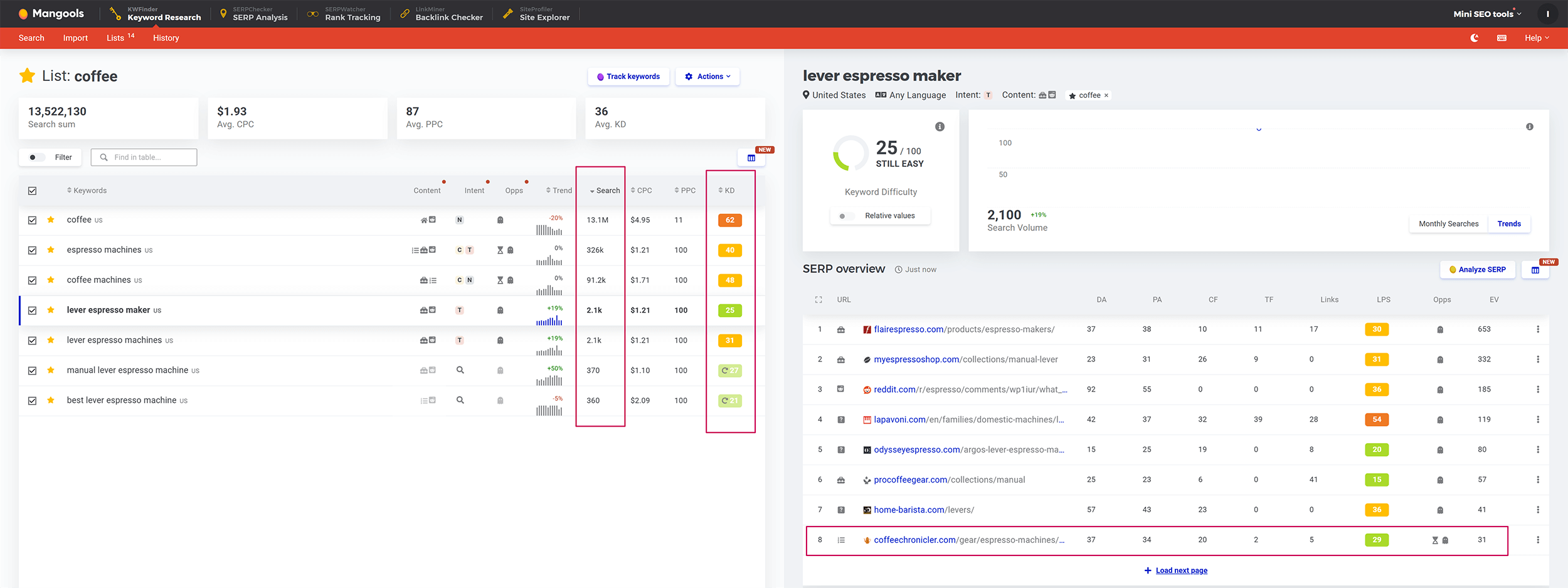
Since it's apparent that I don't want to compete for the keyword "Coffee," I've grouped a few keywords from the "Lever Espresso Machines" category in Mangools and looked at those results. These data points initially look feasible.
With over 15,000 monthly searches, this keyword set definitely has potential, while the average Keyword Difficulty is 25 — manageable, with some effort!
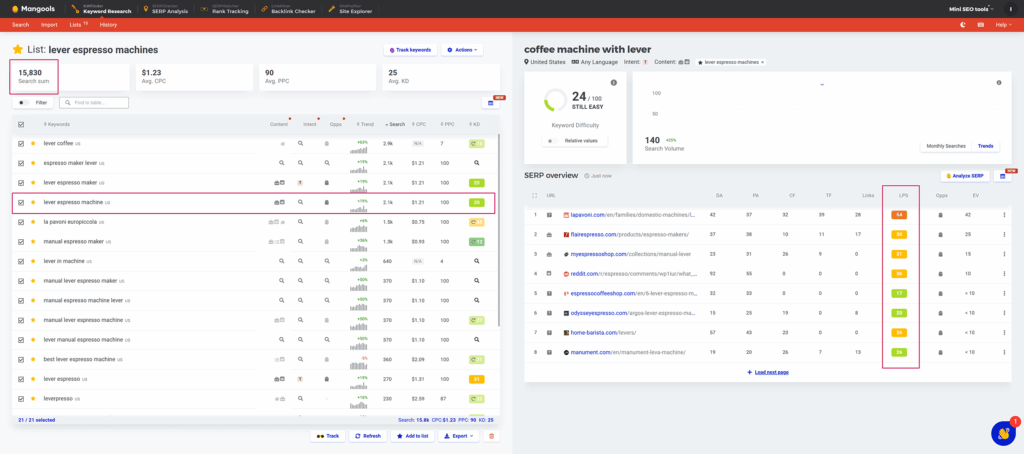
Furthermore, Mangools displays trend values, calculated from the ratio of searches one month ago compared to the same period in the previous year. Here, too, the trend is heading in a positive direction. Evidently, my keyword idea has shown positive growth.
Google Trends analyzes the popularity of search queries over a specific period and in different regions. As an affiliate publisher, you can use it to spot trends and uncover niche potential. For instance, if you see a rising interest in "solar outdoor lights," that's a clear signal to create content and product recommendations around them. Product seasonality can also be well-illustrated, allowing you to prepare campaigns strategically (e.g., "grills" in spring). This way, you optimize your content strategy and maximize your earnings.
Google Trends visualizes the relative search interest for keywords and topics over time and across different regions. The numbers don't show absolute search volumes, but rather a normalized popularity (0-100).
As an affiliate publisher, you use Google Trends to find niches, identify seasonality (e.g., Christmas gifts), validate product demand, and generate keyword ideas for your content. You can also compare competitors to see which products or topics are gaining popularity, thereby optimizing your content and marketing strategy.
When I enter "lever espresso machines" into Google Trends to check the interest for this keyword over time and identify regional hotspots, I see that the topic has shown a continuous growth trend over the last 5 years and is particularly popular in the USA. Gotcha!


Alright, let's start with a straightforward, albeit slightly more manual, approach to size up your competition for free. Pop open your browser in Incognito Mode. This is super important because it strips away any personalization, giving you the raw, unbiased search results.
Now, punch in the main keyword for your affiliate niche site idea into the search bar and simply scan the first two pages of results. Right away, you'll get a feel for the kind of competition you're up against. Are you seeing big online shops, community forums like Reddit, Wikipedia entries, established journalistic sites, massive portals, or other niche sites? You can bookmark any of these pages that seem particularly relevant for a deeper dive later on.
Beyond just the direct competitors, pay close attention to the other elements Google embeds before the actual search results. We're talking about shopping widgets, videos, or featured snippets. In the best-case scenario, these can spark ideas for specific content types that will help your site stand out on the SERPs.
To get an initial impression, I'll type "lever espresso machines" into Google and take a look at the results on the first two pages. What immediately jumps out? No less than four shopping widgets appear before Google even bothers to show the first organic search results! While I could bookmark these pages, I actually find it much quicker and clearer to conduct this analysis directly within KWFinder. I'll show you exactly how that looks in the next section.
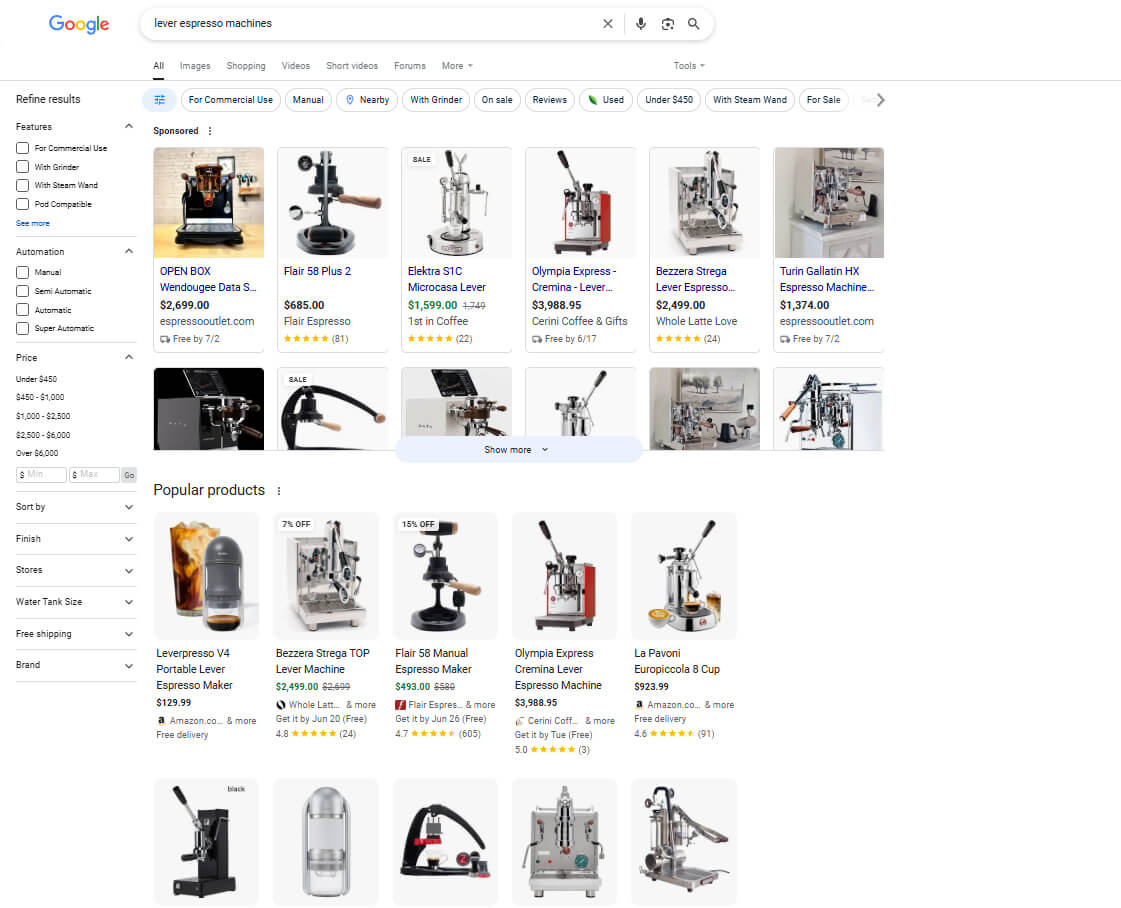
For this analysis, I'm firing up Mangools' KWFinder again. It's integrated competition analysis provides a detailed overview of my competitors in seconds. For every keyword you select in KWFinder, you can pull up this overview in the SERPChecker with a single click. Several of these analyses are extremely useful for evaluating the competition.
Mangools doesn't just show you metrics for your keywords; it also provides insights into the pages already ranking for them. At this point, I'll only mention the most crucial ones – Domain Authority (DA), Links, LPF (Link Profile Flow), and EV (Estimated Visits) – which can help you gauge a website's actual strength and assess whether you can truly compete.
| Metric | Description |
|---|---|
| DA (Domain Authority) | Predicts how well an entire domain will perform in Google search results (scale 0-100). A high DA for competitors makes your ranking more challenging. |
| Links | Shows the total number of external links pointing to the competitor page's URL. Many high-quality links often indicate a stronger page that is harder to outrank. |
| LPS (Link Profile Strength) | Estimates the strength of a URL's link profile and thus how difficult it is to outrank it at that position (scale 0-100). The higher, the more challenging the competition. |
| EV (Estimated Visits) | Provides the estimated monthly visits for a specific SERP position. This helps assess the potential traffic you could receive from that position. |
My first observation is that manufacturers and online shops dominate the SERPs. Then there's Reddit and a YouTube hit. The first two niche sites that fit my scheme appear at positions 9 and 13. The overall Link Profile Strength of the URLs in the first 20 positions, which estimates how difficult it is to rank for that particular position, tends to be more yellow than green.
We're going to take a closer look at these two niche sites. Their rankings for this keyword aren't bad, to begin with. Perhaps there's something I can do even better.
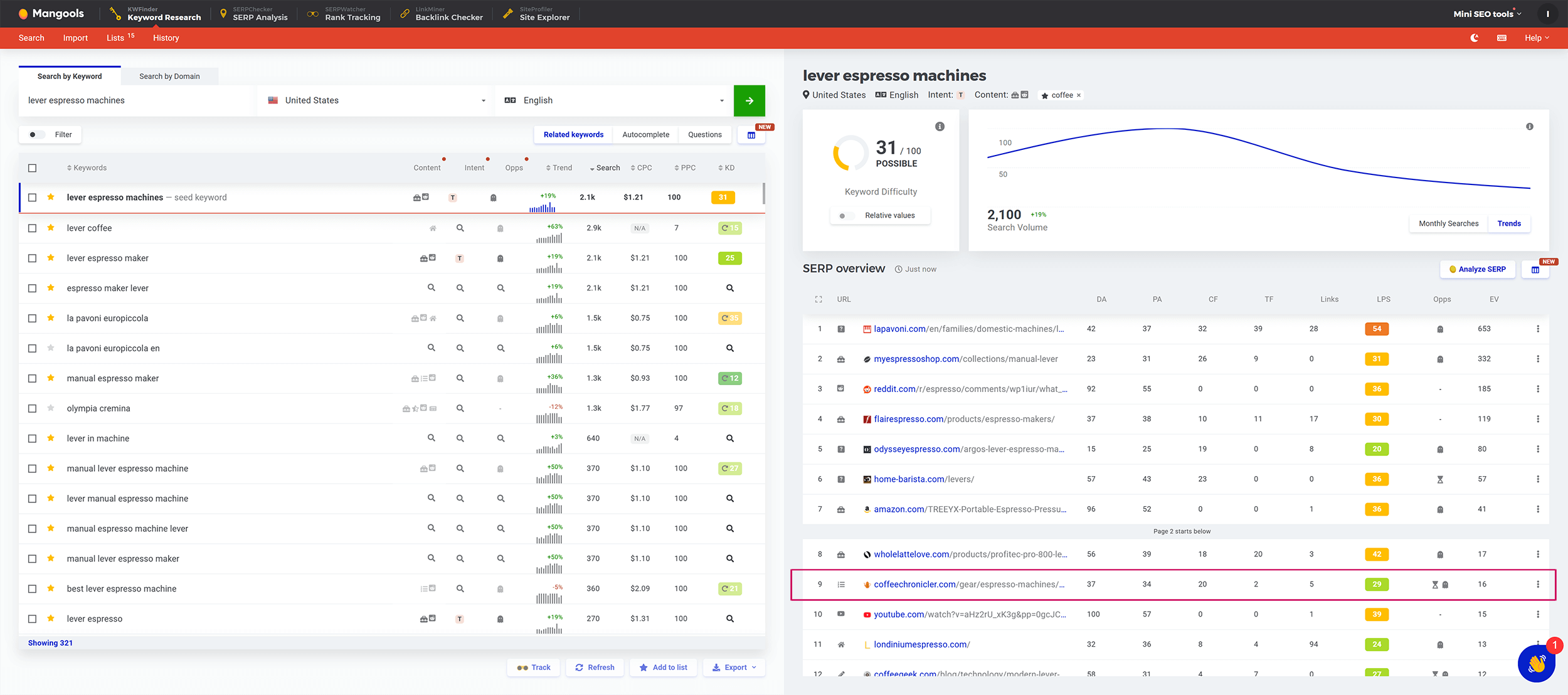
The Lever Mag is a highly specialized platform that dives deep into the world of lever espresso machines. The nerd factor here is pretty high. The authors enjoy expert status, and their reviews are genuinely detailed and knowledgeable. Born initially from a print magazine, the site bundles comprehensive expert knowledge for coffee lovers, exploring the history and potential of these machines.
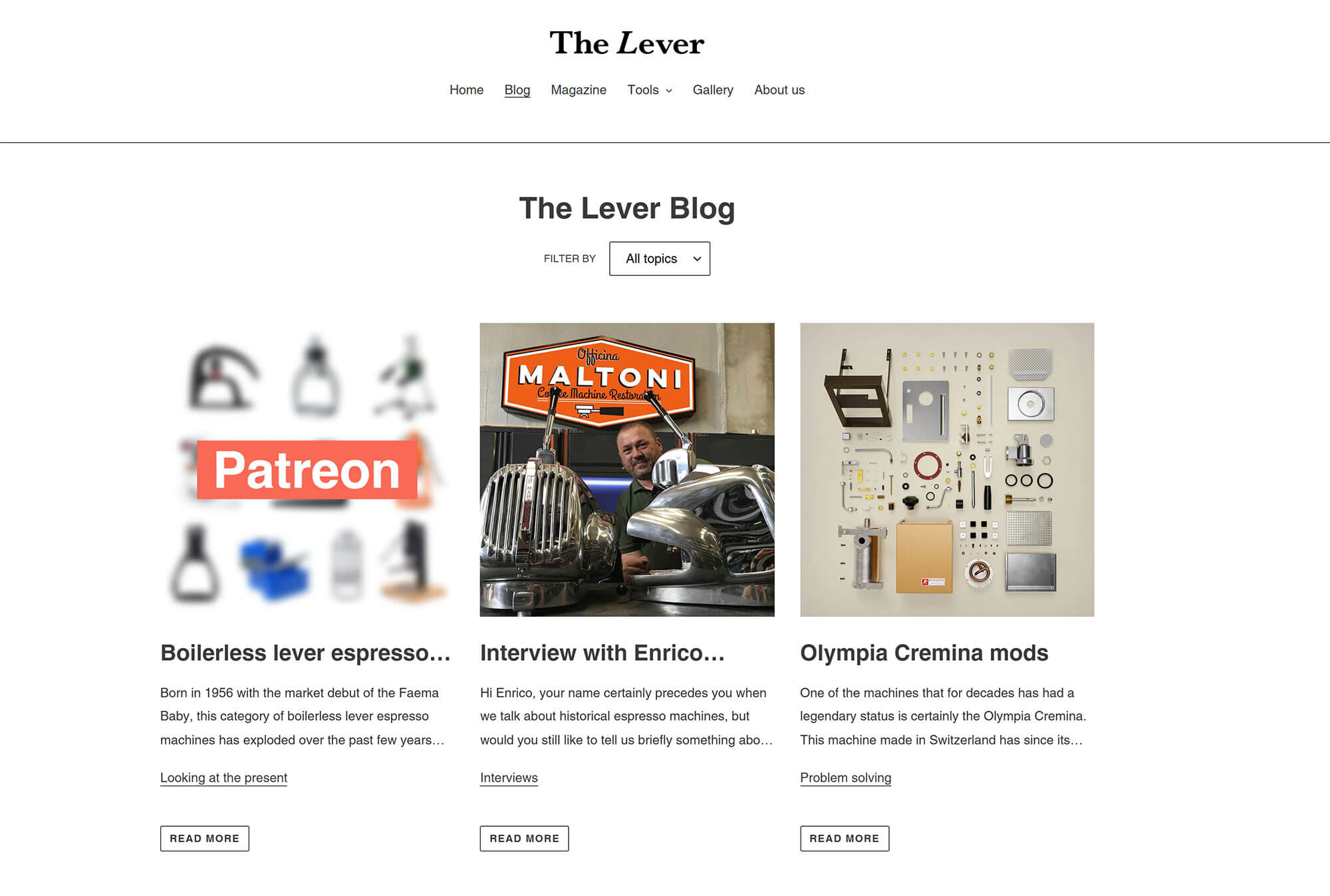
Although the content is excellent and rich in detail, the website visually appears outdated and unoptimized, which significantly impacts the user experience. With around 70 content pages and 300 YouTube subscribers, there's significant room for growth in reach. A standout feature is their "Water Calculator," which allows for the precise adjustment of tap water for coffee – a truly unique tool that offers genuine added value. Yes, it's nerdy, but elements like calculators often provide great user value, and I'm definitely keeping that idea in the back of my mind; who knows what else I can do with it!
Monetization is exclusively through Patreon; affiliate links are entirely missing, even in extensive product reviews, which represents a massive untapped potential. Overall, due to its lack of optimization and marketing, The Lever Mag offers significant opportunities to overtake it in rankings with targeted content and beginner-friendly guides.
The other affiliate niche site that ranks reasonably well and holds its own against numerous shops does a bit better. This site has a more general focus and isn't a direct "Lever Espresso" competitor. The Coffee Chronicler is an established coffee website run by experienced journalist and Q Arabica Grader Asser Christensen. Although it covers a broader coffee topic, it also ranks for "Lever Espresso Machine," making it a relevant competitor.

The site impresses with its modern, minimalist design and straightforward navigation, offering both guidance for newcomers and practical help. Besides in-depth product reviews, blog articles, and guides, it features a special "Gear" section with product boxes and affiliate links.
With over 200 content pages and a YouTube channel boasting 50,000 subscribers, the site demonstrates a high level of expert status and comprehensive content. Monetization occurs via Amazon, using the AAWP plugin, and other affiliate programs. While a direct assault would be challenging, a narrower focus on "Lever Espresso Machines" offers a clear opportunity to outperform The Coffee Chronicler in this specialized area.
To truly grasp the strength of your direct competitors, it's incredibly valuable to peek into their backlink profiles. Since I'm already relying on Mangools as my primary keyword research tool, I naturally gravitate towards LinkMiner by Mangools, which is the backlink tool within their toolkit. While it might not be as powerful as, say, Ahrefs, it's significantly more affordable and handles my tasks with flying colors.
If you're keen on sticking to free tools, you'll find several options online. Typically, these are just "lite" versions of paid services. Nevertheless, even with their limited information, you can still gain valuable insights.
Useable free SEO Tools:
Plus, additional free dedicated Backlink Tools:
There's absolutely no harm in signing up for as many tools as possible initially, leveraging their free features, and combining insights from different ones. For starters, this will be more than enough. However, eventually, you'll reach a point where you'll want to conduct your keyword research, SEO work, or link-building efforts without limitations.
For my sites, I specifically use the SERPChecker and LinkMiner from the Mangools suite. These tools give you a solid impression of your competitors' strength.
If a competitor's backlink profile predominantly consists of bookmarks, links from comments, directories, and article directories, that's generally a good sign. With just a few really high-quality links, I can zoom past that competitor. Should you spot a few genuinely good links in their profile, make sure to save those sources immediately. You can leverage them later!
It's pointless to analyze the backlink profiles of giants like Amazon or other massive sites. You simply won't be able to deduce any actionable patterns from their millions of links.
A first glance at the Mangools LinkMiner reveals that while thelevermag.com is an absolutely nerdy expert site, its backlink profile looks pretty bare. It only has 33 active backlinks from 12 domains, and none of them are from a compelling site; instead, there are many forum links. This presents a clear opportunity to attack them on the backlink front and build a stronger backlink profile.
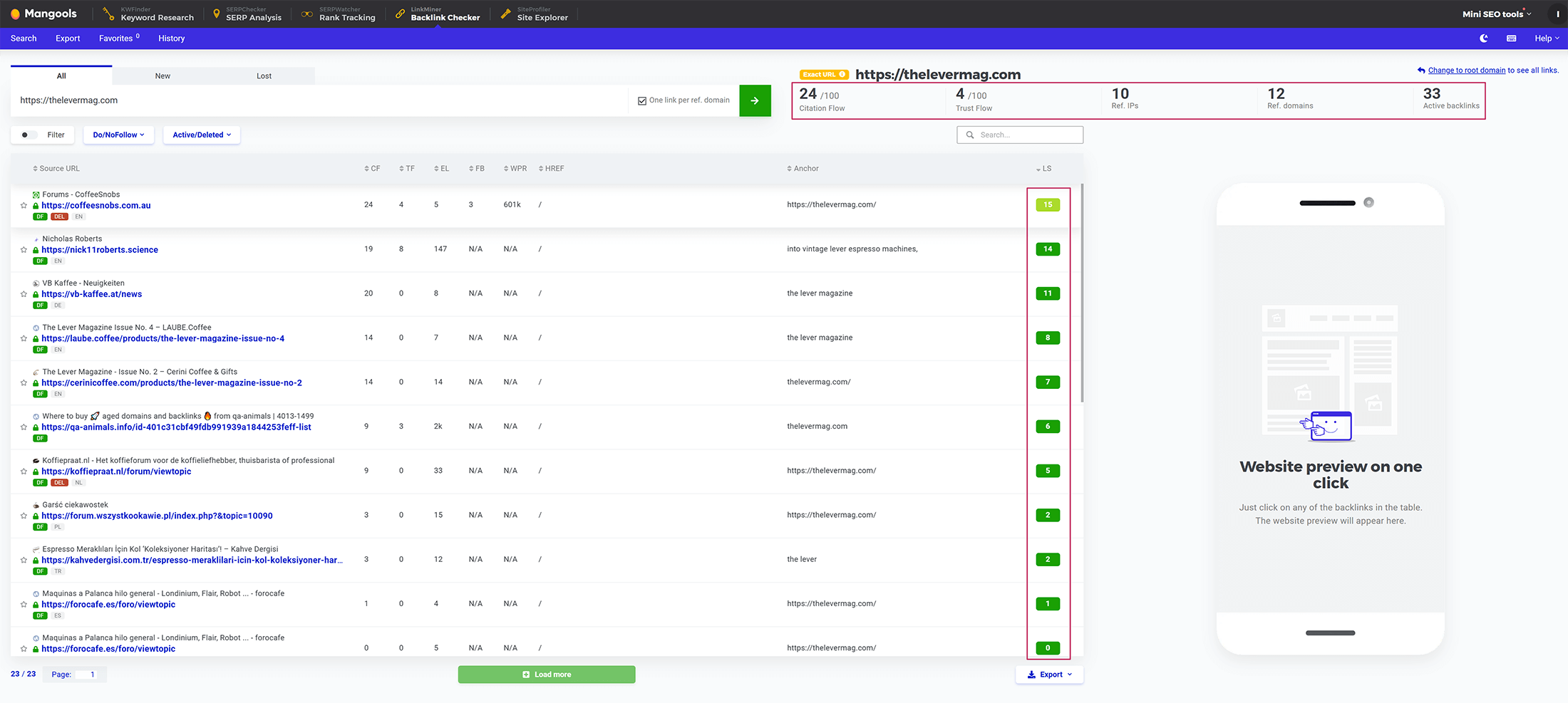
The backlink profile of coffeechronicler.com is more challenging. Here, LinkMiner counts 290 active backlinks from 192 domains and lists significantly more citations. Among these backlinks are a few heavyweights, such as The New York Times' affiliate project, Wirecutter, with a link strength of 51. But even beyond this top-tier link, other high-quality backlinks are immediately visible that aren't easily replicable and will require extra effort.
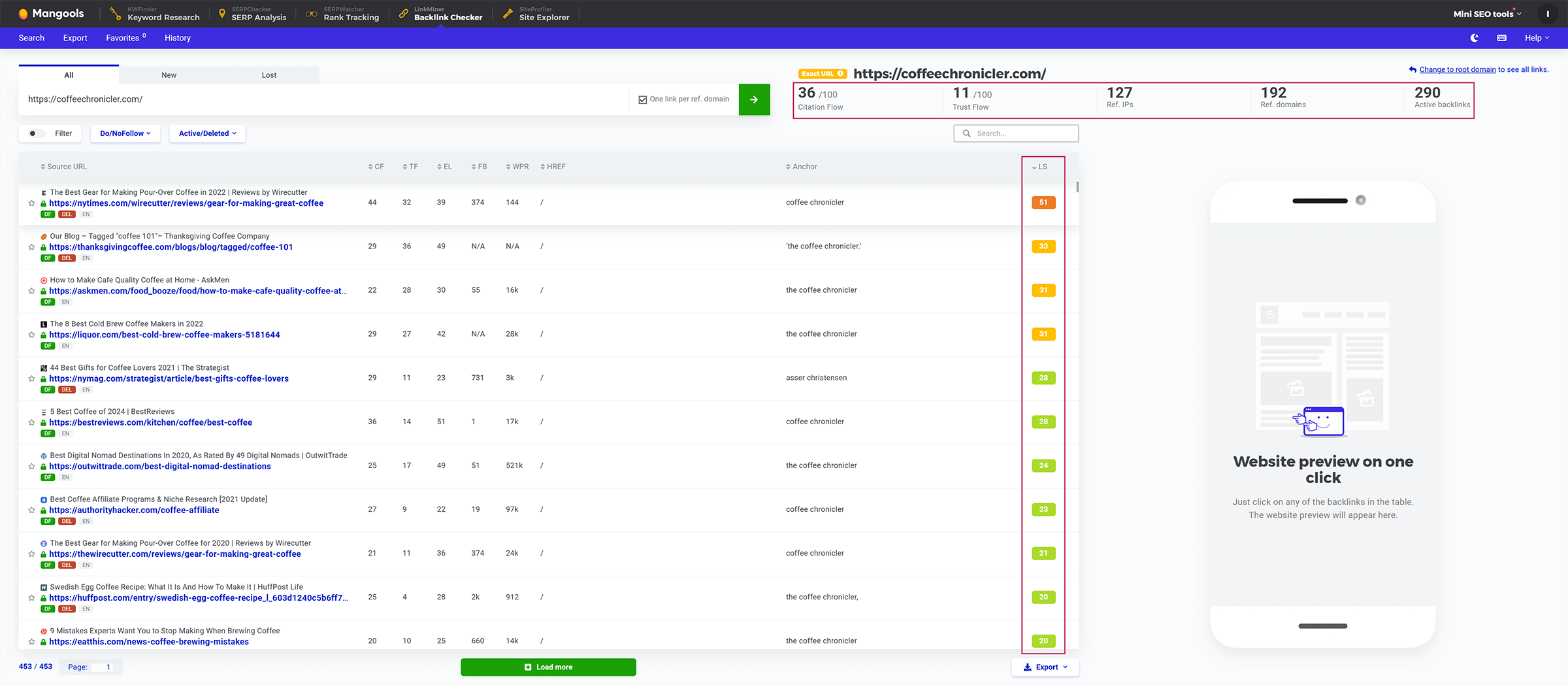
The Lever Mag offers significant opportunities for you to overtake it with moderate effort, thanks to its excellent but poorly presented and unmonetized expert content. Its weaknesses in design and its manageable number of backlinks are a big leverage point for you.
The Coffee Chronicler, due to its high quality, broad positioning, and strong monetization, is a tougher opponent. A higher SEO effort is also needed here. Still, a narrower specialization on lever machines can help you score points in this niche at least, and outperform it on selected keywords.
You should promote products on your affiliate niche site that have many reviews and a high sales rank. This way, you can be sure that there's real demand for the products.
First, you need to find out where the products you want to promote are even sold. For this, I simply recommend searching for your niche on Google, possibly adding "buy" to your search query. Alternatively, you can search in large online stores like Amazon. Pay special attention to cross-promotion (customers who bought this product were also likely interested in this product) to discover further product ideas, such as accessories.
How expensive do the products you want to sell on your affiliate niche site need to be? There's no clear-cut answer to this question.
At this point, I always refer to what I call the "Magic Formula" of affiliate marketing. With this formula, you can precisely calculate your affiliate earnings. I explain this formula in detail elsewhere, but even just by looking at it, you can see that the conversion rate (how many of those who clicked a link on your site actually buy) and the price have just as much influence on your earnings as your traffic.
The "Magic Formula" for estimating an affiliate site's potential is:
Revenue=PageViews × CTR (in %) × Conversion Rate (in %) × Commissions (in %) × Product Price
A generally accepted rule in affiliate marketing is that a lower selling price leads to a higher number of sales (with a lower commission). Conversely, a high selling price results in a lower number of sales but generates a higher commission.
The ideal selling price for products, therefore, lies somewhere in the middle, and you need to find the sweet spot for your audience.
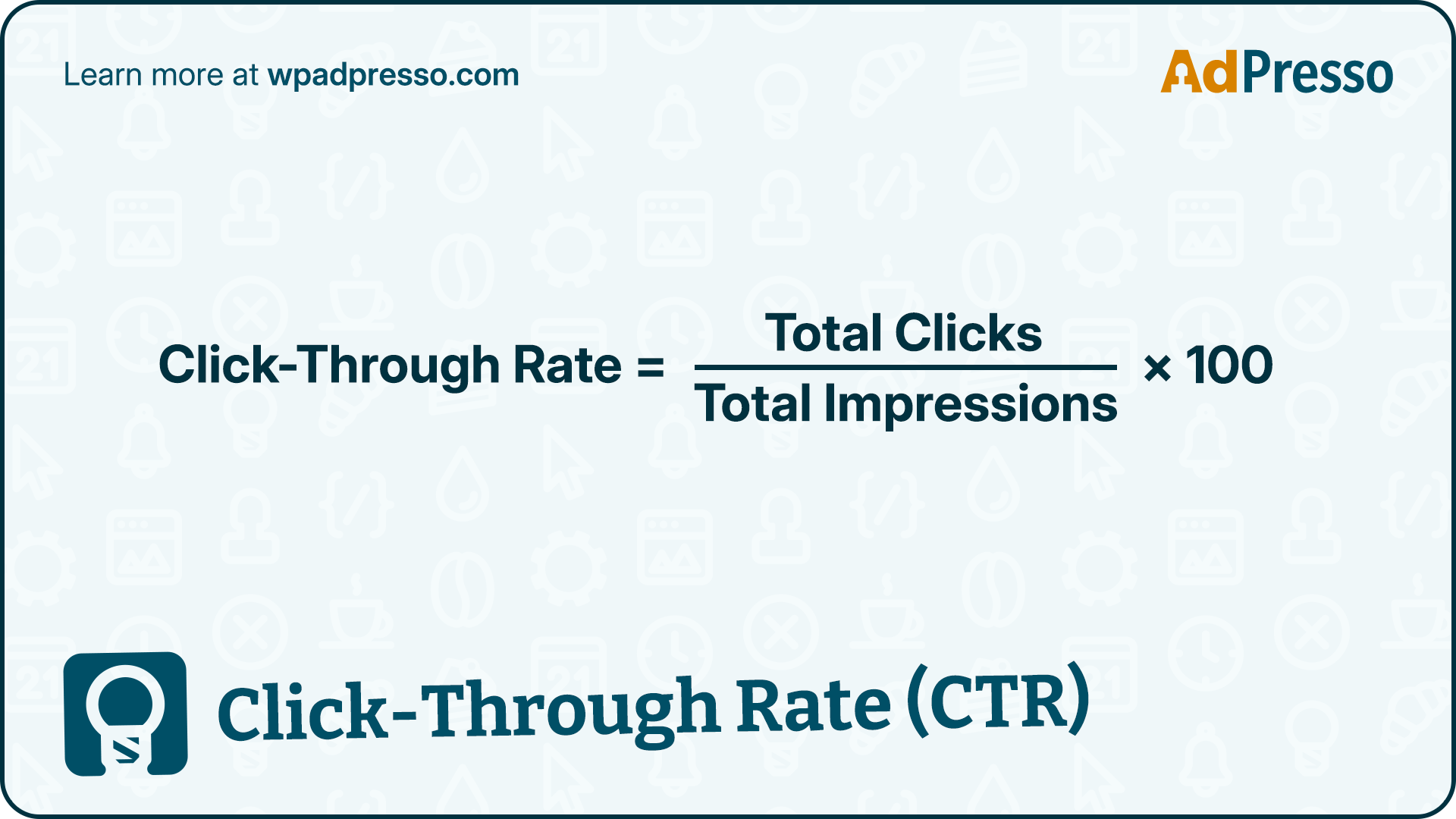
In many cases, Amazon's affiliate program will be your top choice. Almost everyone has an Amazon account. Amazon enjoys trust like almost no other online shop. The numerous product reviews further underscore this. On average, I achieve a conversion rate of just over 12 percent with Amazon. With other shops, unfortunately, that looks significantly worse. When someone buys something via your affiliate links on Amazon, all other items in their cart are automatically compensated. A nice bit of incidental catch, so to speak!
One drawback of the Amazon Associates program, however, is the relatively low commission rate, which varies considerably by product category.
Amazon pays different commission rates depending on the product category. As you can see in the table, it's currently not worth promoting products like TVs, smartphones, or tablets via Amazon anymore. Other categories, however, are extremely interesting, with commissions up to 20%.
Affiliate networks often bundle thousands of merchants, connecting them with affiliates. This means you only need a single overarching account for the network, rather than a new one for each affiliate program. They typically offer a solid technical foundation for accessing advertising materials, detailed reporting, and proper accounting for payouts.
You should sign up with an extensive ad network, such as CJ or AWIN, to find suitable merchants for your affiliate niche site and monetize them optimally. Additionally, you should Google "[your product] + affiliate" to discover ad networks where the merchant is a partner, or to find an in-house affiliate program.
Take a close look at the online shops you plan to promote and ask yourself: Would I buy from here myself? There's no point in just chasing high commissions if you end up selling nothing. The promoted site should have a reputable appearance, a certain level of recognition, and be user-friendly. Click through the entire sales process to test it out. Only then can you be sure that the visitors you send there will make a purchase. Multiple payment methods, free shipping, and trust seals etc., are additional positive attributes the shop should possess.
You're already analyzing your potential competitor sites, right? Great! Then you can simultaneously keep an eye on which affiliate programs they're using to monetize their websites. Afterward, you can check if these partner shops run their affiliate program or if they maintain a partnership with an ad network.
You won't find many products under 10$ for which it's worth creating a niche site. This is likely because such products usually don't require much explanation.
If the competition is too intense, then the only option is to check if it makes sense to specialize further and narrow down the niche. If that doesn't help, you should ask yourself if it wouldn't be wiser to abandon the idea and continue searching for another affiliate niche site concept.
A quick search reveals that there's a wide range of lever espresso machines available across different budget classes, along with a vast variety of accessories.
| Category | Product | Price Range (USD) | Description |
|---|---|---|---|
| New Lever Espresso Machines | Entry-Level | $100 - $500 | Manual/portable machines (e.g., Flair Neo Flex, Flair Classic). Ideal for beginners. |
| Mid-Range | $600 - $2,000 | Semi-professional models (e.g., La Pavoni Europiccola, Bezzera Strega). For ambitious home baristas. | |
| High-End | $2,000 - $5,000 | Professional and luxury machines (e.g., Profitec Pro 800, Olympia Cremina). For the highest demands. | |
| Popular Accessories | Coffee Grinder (Espresso) | $50 - $200 (Manual) / $150 - $500 (Electric) | Essential for a fresh, consistent grind size. |
| Tamper | $20 - $150 | For compressing coffee grounds in the portafilter. | |
| Knock Box | $25 - $100 | A container for knocking out spent coffee grounds. | |
| Precision Scale (with Timer) | $30 - $250 | For precise dosing of coffee and water. | |
| Milk Pitcher | $10 - $40 | For steaming milk for latte art. | |
| Distribution Tool (WDT Tool/Leveler) | $15 - $80 | Improves coffee distribution in the portafilter. | |
| Puck Screen | $10 - $30 | Helps with even water distribution and a cleaner group head. | |
| Cleaning Brushes/Tools | $5 - $20 | For daily care and maintenance of the machine. | |
| Tamping Mat | $10 - $30 | Protects the workspace when tamping. |
Visitors can purchase these products through both Amazon and several specialized online shops with affiliate programs. The price range, from budget to luxury products and more affordable accessories, reveals significant potential for this affiliate niche site idea. Okay, you've got me! This is definitely something I can work with. It's time, in the next step, to delve into intensive keyword research and develop a solid plan.
A meticulous competition and potential analysis form the indispensable foundation for any successful affiliate niche site. It helps you determine whether your idea is viable and how to position yourself in the market. By classifying your affiliate niche site as either a portal or product-related, you lay the groundwork for your content and monetization approach.
The potential analysis – using tools like Mangools KWFinder and Google Trends – uncovers demand and reveals the relevance of your topic. Simultaneously, the Keyword Difficulty (KD) provides insight into your ranking chances. A deeper examination of product prices, commissions, and affiliate programs secures the economic viability of your niche and helps you find the sweet spot for your revenue.
In a competition analysis, it becomes clear that weaknesses in competitors are your opportunities. Whether through untapped monetization potentials, design that needs improvement, or low backlink numbers, with strategic content and targeted link building, you can position yourself. A specialized approach, especially in a competitive market, can provide the decisive advantage to outperform competitors.